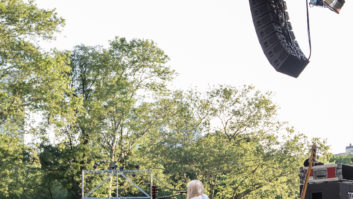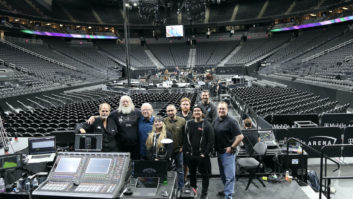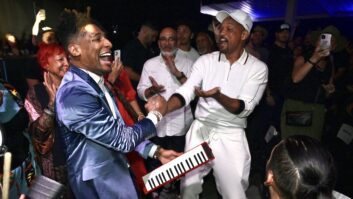In 1998, close to 1 million fans flocked to see the George Strait Country Music Festival, a one-day, seven-act show staged in 18 football stadiums around the U.S. This year’s Straitfest ’99 again offered concert-goers an alluring lineup of established and fast-rising country stars, a day in the sun and a wide range of associated amusements, including a traveling carnival and “country fair” that set up in the parking lot of each venue. Playing no more than three weekends per month and featuring the same lineup throughout-Asleep at the Wheel, Mark Wills, Jo Dee Messina, Kenny Chesney, the Dixie Chicks, Tim McGraw and George Strait-the tour started in the ASU Sun Devil Stadium in Tempe, Ariz., in March and wound up at Three Rivers Stadium, Pittsburgh, in June. Mix caught the Oakland Coliseum show on Sunday, May 9.
Because of the setup time required for a stadium show, Straitfest has been touring with completely separate Saturday and Sunday productions, including two stadium-sized Prism sound systems from Dallas-based Showco. And because of the distances between successive shows, on Sundays show opener Asleep at the Wheel often appears onstage hours before George Strait’s band equipment arrives from the Saturday night venue. Without the safety net of a soundcheck, each of the bands’ monitor and FOH engineers relies on Saturday’s board settings for the start of each Sunday set. Last year, in order to ensure consistency and minimize the surprises that can occur in a multi-act show, each band carried its own monitor and FOH console.
“Carrying seven separate consoles involves enormous expense, and not just in terms of hardware,” says Showco vice president Howard Page. “There’s truck space and setup time to factor in, too, and you have to build a front-of-house mixing platform large enough for seven mixers and their effects racks.”
Showco’s solution for Straitfest ’99 is the Showconsole, a new digitally controlled analog audio mixing console developed jointly by Showco and Harrison (Nashville). Six different FOH engineers use the Showconsole for six different acts, yet the switchovers are seamless. Every mixer starts out with all of the Showconsole’s many control and routing functions exactly recalled to previously stored settings, regardless of any previous engineer’s configuration changes and level trims.
“Everything shows up where you want it,” says Paul Rogers, headliner George Strait’s FOH mixer and tour production manager. “It remembers everybody’s settings, and when you go to your icon and click on it, then your settings are there on the console.
All of the bus assignments, the auxiliary sends, the EQ-it all shows up exactly the way it was when you walked away from it. We’re doing multiple acts all day long, yet we’re using just the one console to do it with. I’m incredibly happy with this console-it’s made my life very easy.”
SECRETIVE DEVELOPMENTThe result of a long and secretive development collaboration between Showco and Harrison, the Showconsole system consists of a 6-foot-long digital control surface and a three-wide audio processing rack that is normally situated on or near the stage and contains all of the audio cards and I/O interfaces. An automation computer in the processing rack executes all changes to routing and signal processing, as instructed by the digital control surface via a fiber-optic link. Any fader moves or EQ changes at the control surface are immediately executed at the audio processing racks. Since no audio passes through the control surface, any interruption in the digital data stream passing between the control surface and the processing racks is effectively inaudible-all audio assignments, levels and EQs remain frozen until the system resets and the control surface picks up where it left off.
“Having spent most of my life as a working mixer, I was absolutely determined to make the Showconsole as bulletproof as possible,” says Page. “There are complete backup computers for both the console and the processing racks, and since you don’t lose audio at any time, you can turn the console off and on again in the middle of a show.”
Redundancy and fail-safe operation were high priorities for the console designers. Showco’s design specification also stressed that the new board must be, if not familiar, at least immediately understandable to any road engineer. “We’re a rental company, so almost anyone has to be able to sit down and be able to mix on it straight away,” says Page. “The board has lots of advanced routing functions and automation options, but an engineer has to be able to get comfortable with the signal flow straight away. The term ‘digitally controlled console’ is going to cause a bit of fear in some people anyway, so you can’t subject new users to a steep learning curve.”
FAMILIAR LAYOUTIn fact, the Showconsole closely resembles a traditional analog mixing board, with two 20-fader input sections flanking the centrally located 16-fader subgrouping and auxiliary master sections, which are stacked one above the other. Under the operator’s right hand is a central control section that includes numeric keypads (to recall favorite presets or to select channels or cues by number) and a trackball to point and click on a monitor screen embedded in the meter bridge. Immediately above the automation/recall control section are arrayed the familiar components of a traditional channel strip-mic input trim and pan, 4-band parametric EQ, 16 aux sends and a full dynamics section. As on other digitally controlled consoles, there is only one “input strip” for the entire console; the operator simply selects the desired channel and all of the input, EQ, dynamics and aux send controls instantly reset to that channel’s settings.
Though there are only 40 channel faders, they may be used to control up to 80 “live” inputs in two banks. Illuminated switches above each input fader select between the two inputs, and an LED “scribble strip” above the faders identifies both upper and lower inputs, either by number or with a user-defined, four-character label. Similarly, the 16 aux send masters can control twice that number of aux sends and/or matrix outputs. This banking scheme allows the Showconsole to easily handle 80 inputs, which may be grouped in up to 16 virtual subgroups and routed to as many as 32 aux or matrix outputs, in addition to four stereo main outputs. Further, because each input may be switched among three mic inputs and one line input, the Showconsole can instantly switch among 240 mics and 80 line inputs.
“That’s not the way I run the console, because with George Strait’s band I don’t have a bunch of different types of scenes to look at,” says Rogers. “In other words, pretty much all my mics are on all the time. But if you were doing somebody like Phil Collins, he’ll go from a full-blown orchestra with 100 channels to just him and an acoustic. So you can set up a song list on the computer and just click down to each song and it will reset completely to what you want that song to be.” The Showconsole system is capable of recalling up to 10,000 individual cues, more than enough for the most complicated Broadway show, TV awards show or effects-heavy rock extravaganza.
CHANGEOVER AND ISOLATEThough the Showconsole’s ease of cue recall may have been underused for Straitfest, one interesting feature ensured that between-sets announcements and music playback were uninterrupted when the board was switched to a line-check mode. An Isolate function allows any input, group or aux fader to be isolated from the automation system so that, for example, the announce mic and CD playback inputs could be left on while the board was switched to an all-mute or standby mode while the next band’s inputs were checked. On an extensively automated show, the Isolate function allows a mixer to add guest musicians without worrying that the next recalled cue might mute the extra inputs.
Another clever touch is the inclusion of an assignable pot for every input channel. Normally inactive, the assignable pot may be individually selected to function as an input gain, pan or aux send control, duplicating functions normally controlled by the central channel control section but placing a dedicated control nearer to hand. An engineer can even use the assignable pots as level controls to bring the 40 “hidden” channels to the surface at the same time as the fader-controlled inputs. The space above the rotary pots-real estate taken up by EQ and aux send sections on a traditional console-is dedicated to a channel-display section that includes status indicators to show input and mix bus assignments, and LED ladders to show input levels and gain reduction when the dynamics section is in use. Large-scale 40-segment output meters in the meter bridge are marked in VU and PPM scales, though Showco’s Page says that the actual meter ballistics are a hybrid of the two standards.
“Some of the Showconsole’s features, like the meter ballistics and the screen interface, are still being refined,” says Page. “As we get more experience with the board on different types of shows we may modify the software, but the basic form won’t change. We’ve proven the concept, the board is roadable and stands up to real-world conditions-we had a dust storm a few weeks ago at the Sun Bowl in El Paso-and the mixers all like it.” Just the day before the Oakland show, Showco delivered a second Showconsole for the Saturday production, preloaded with all of the current Straitfest show cues. And, provided the bands’ monitor engineers prove as compliant as the FOH engineers, Straitfest 2000 will probably feature one or more Showconsoles onstage as monitor boards.
LINE LEVEL RETURN SNAKEAs Page and Rogers readily concede, audio requirements for Straitfest are far from complicated; none of the acts consumes more than 32 inputs, and the only notable differences among the seven lineups were the numbers of fiddle, banjo and backing vocal inputs. Though the Showconsole offers gates and compressor/limiters on every channel, few of the mixers used them extensively. “I have no gates on at all, and the only compressor I use is on the bass guitar,” says Rogers. “But I am a very old-style type of mixer-I use as little outboard gear as I can. In fact, the only outboard gear I use is two reverb units-Yamaha SPX990 and REV5 units.”
Because there is no audio in the Showconsole, reverbs and other outboard processors must be plugged into a line-level return snake that runs back to the audio processing rack at the stage. And since the Prism system front end rack is designed to be located at the mix position, the Showconsole outputs must also be brought back to the FOH position. In the future, reverbs may be located onstage and manipulated via MIDI, but Page concedes that most engineers will likely want to keep their favorite effects within knob-twiddling distance.
Having chosen to debut the Showconsole on a demanding multi-act tour, Page is justifiably proud of the system’s technical performance and reliability. But it is the sound of the Showconsole that has impressed those who have worked with it-several of the Straitfest FOH mixers volunteered positive reviews unasked. And though he is not sure whether the Showconsole is responsible, Rogers notes that overall sound quality for the Straitfest has improved. “It was a real surprise,” he muses. “When you have seven different mixers, obviously you’ll get seven different sounds, but last year it was radically different to the point that we had meetings about it. This year, I’m not saying it’s the console, but it has all settled down. I don’t know if that’s [a result of] better engineers this year, or what. I think it has something to do with the fact that we’re all starting at the same ground zero-there is a consistency.”







